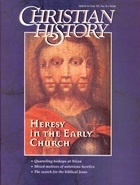[* Adapted from “Creeds, Councils, and Controversies: Documents Illustrative of the History of the Church, A.d. 337–461,” edited by J. Stevenson (SPCK, 1966) and Peter L’Huillier, “The Church of the Ancient Councils: The Disciplinary Work of the First Four Ecumenical Councils” (St. Vladimir’s Press, 1996).]
The Chalcedonian Definition of the Faith (451) set the boundaries in which Christians were to think about Jesus Christ. Though a few churches have disagreed, the vast majority of Christendom has submitted to this “definition.” Here, the most relevant section is broken into thought blocks:
Some, taking in hand to set aside the preaching of the truth by heresies of their own, have uttered vain babblings, daring to pervert the mystery of the dispensation.…
The synod is opposed to those who presume to rend asunder the mystery of the Incarnation into a double Sonship.
It deposes from the priesthood those who dare to say that the Godhead of the only begotten is passable.
It withstands those who imagine a mixing or confusion of the two natures of Christ.
It drives away those who erroneously teach that the form of a servant he took from us was of a heavenly or some other substance.
It anathematizes those who feign that the Lord had two natures before the union but that these were fashioned into one after the union.
Therefore, following the holy fathers, all of us teach unanimously that everyone must confess that our Lord Jesus Christ is one single and same Son, who is perfect according to divinity and perfect according to humanity,
truly God and truly man, composed of a reasonable [i.e., rational] soul and a body, consubstantial with the Father according to divinity and consubstantial with us according to humanity, completely like us except for sin;
he was begotten by the Father before all ages according to his divinity, and in these latter days, he was born for us and for our salvation of Mary the Virgin, the Mother of God, according to his humanity,
one single and same Christ, Son, Lord, only begotten, known in two natures, without confusion, without change, without division, without separation;
the difference in natures is in no way suppressed by their union, but rather the properties of each are retained and united in one single person and single hypostasis [“substance”];
he is neither separated nor divided in two persons, but he is a single and same only-begotten Son, God the Word, the Lord Jesus Christ,
such as he was announced formerly by the prophets, such as he himself, the Lord Jesus Christ, taught us about himself, and such as the symbol of the fathers [the Nicene Creed] has transmitted to us.
Copyright © 1996 by the author or Christianity Today/Christian History magazine.
Click here for reprint information on Christian History.

Support Our Work
Subscribe to CT for less than $4.25/month




























